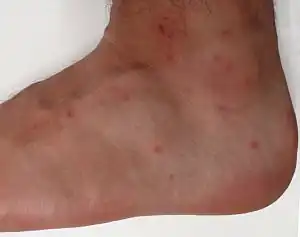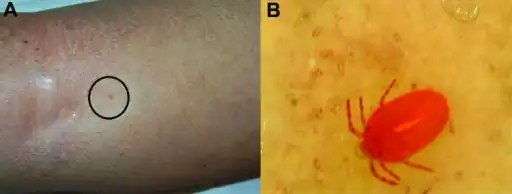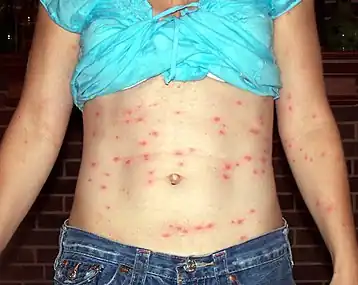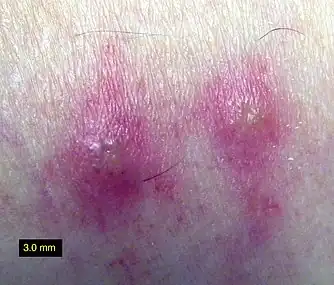Trombiculosis
| Trombiculosis | |
|---|---|
| Other names: Trombiculiasis, or Trombiculidiasis | |
 | |
| Chigger bites on the foot and ankle | |
Trombiculosis is a rash caused by trombiculid mites, especially those of the genus Trombicula (chiggers). The rash is also often known as chigger bites Chiggers are commonly found on the tip of blades of grasses to catch a host, so keeping grass short, and removing brush and wood debris where potential mite hosts may live, can limit their impact on an area. Sunlight that penetrates the grass will make the lawn drier and make it less favorable for chigger survival.
Chiggers seem to affect warm covered areas of the body more than drier areas.[1][2] Thus, the bites are often clustered behind the knees, or beneath tight undergarments such as socks, underwear, or brassieres. Areas higher in the body (chest, back, waist-band, and under-arms) are affected more easily in small children than in adults, since children are shorter and are more likely than adults to come in contact with low-lying vegetation and dry grass where chiggers thrive. An exceptional case has been described in the eye,[3] producing conjunctivitis.
Application of repellent to the shoes, lower trousers and skin is also useful. Because they are found in grass, staying on trails, roads, or paths can prevent contact. Dusting sulfur is used commercially for mite control and can be used to control chiggers in yards. The dusting of shoes, socks and trouser legs with sulfur can be highly effective in repelling chiggers.[4]
Another good strategy is to recognize the chigger habitat to avoid exposure in the first place. Chiggers in North America thrive late in summer, in dry tall grasses and other thick, unshaded vegetation. Insect repellents containing one of the following active ingredients are recommended: Permethrin, DEET, catnip oil extract (nepetalactone), citronella oil or eucalyptus oil extract. However, in 1993 issue a study reported on tests of two commercial repellents: DEET and citrus oil: "All chiggers exposed on the filter papers treated with DEET died and did not move off the treated papers. None of the chiggers that were placed on papers treated with citrus oil were killed."[5] It was concluded that DEET was more effective than citrus oil.
Chiggers can also be treated using common household vinegar (5% acetic acid).
 a) Clinical features and dermoscopy findings b) shows a Neotrombicula autumnalis mite attached to skin
a) Clinical features and dermoscopy findings b) shows a Neotrombicula autumnalis mite attached to skin Chigger rash 36 hours after exposure
Chigger rash 36 hours after exposure Chigger bites showing characteristic raised and fluid-filled center
Chigger bites showing characteristic raised and fluid-filled center
References
- ↑ "ArmaXX Pest Control". Archived from the original on 2009-02-04. Retrieved 2008-06-24.
- ↑ Ogg, Barb. "Itchy Chiggers". Archived from the original on 2009-05-05. Retrieved 2009-05-19.
- ↑ Parcell, B. J., Sharpe, G., Jones, B. & Alexander, C. L. 2013: Conjunctivitis induced by a red bodied mite, Neotrombicula autumnalis. Parasite, 20, 25. doi:10.1051/parasite/2013025
- ↑ M Bennett, Stuart (2003). "Mites". Self published by author. Archived from the original on 2011-08-11. Retrieved 2009-05-19.
- ↑ Ho TM, Fauziah MK (March 1993). "Laboratory evaluation of two commercial repellents against Leptotrombidium fletcheri (Acari: Trombiculidae)". Southeast Asian Journal of Tropical Medicine and Public Health. 24 (1): 165–9. PMID 8362291.
External links
| Classification |
|---|